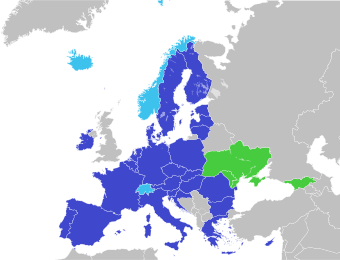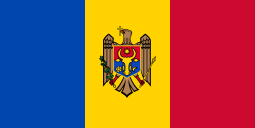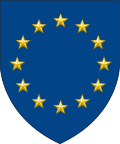Deep and Comprehensive Free Trade Area
The Deep and Comprehensive Free Trade Areas (DCFTA) are three free trade areas established between the European Union, and Georgia, Moldova and Ukraine respectively. The DCFTAs are part of each country's EU Association Agreement. They allow Georgia, Moldova and Ukraine access to the European Single Market in selected sectors and grant EU investors in those sectors the same regulatory environment in the associated country as in the EU.[1] The agreements with Moldova and Georgia have been ratified and officially entered into force in July 2016, although parts of them were already provisionally applied. The agreement with Ukraine was provisionally applied since 1 January 2016 and formally entered into force on 1 September 2017.

Unlike standard free trade areas, the DCFTA is aimed to offer the associated country the "four freedoms" of the EU Single Market: free movement of goods, services, capital, and people. Movement of people however, is in form of visa-free regime for short stay travel, while movement of workers remains within the remit of the EU Member States.[2] The DCFTA is an "example of the integration of a Non-EEA-Member into the EU Single Market".[3]
The European Parliament passed a resolution in 2014 stating that "in accordance with Article 49 of the Treaty on European Union, Georgia, Moldova and Ukraine, as well as any other European country, have a European perspective and can apply for EU membership in compliance with the principles of democracy, respect for fundamental freedoms and human rights, minority rights and ensuring the rule of law", thus formally recognizing the possibility of a future EU membership of the three countries.[4]
Background
While work on signing a deep and comprehensive free trade agreement between Ukraine and the EU first began in 1999,[5] formal negotiations between the Ukrainian government and the EU Trade Commissioner were not launched until 18 February 2008.[6] As of May 2011 there remained three outstanding issues to be resolved in the free trade deal: quotas on Ukrainian grain exports, access to the EU's services market and geographical names of Ukrainian commodities. Aside from these issues, the deal was ready.[7] Despite those outstanding issues, Ukraine was ready to sign the agreement as it stood. Although it wanted stronger wording on enlargement prospects and access to the EU market for its truckers, Ukraine had more than many other candidates at the equivalent stage of the process. The finalised agreement was initialed on 19 July 2012.[8] Ratification of the DCFTA, like the AA, has been stalled by the EU over concerns over the rule of law in Ukraine.[9][10][11] This includes the application of selective justice, as well as amending electoral laws. As a result, the role of Ukrainian oligarchs in sanctioning the agreement was also questioned.[12]
If Ukraine would choose the agreement, the Eurasian Economic Commission's Customs Union of Belarus, Kazakhstan and Russia would withdraw from free trade agreements with the country, according to Russian presidential advisor Sergei Glazyev.[13] However, on 21 November 2013 a Ukrainian government decree suspended preparations for signing the agreement that was scheduled to be signed during a 28–29 November 2013 EU summit in Vilnius, and it was not signed.[lower-alpha 1][lower-alpha 2][19][20][21][22][23][24][25][26][27] The decision to put off signing the association agreement led to the 2014 Ukrainian revolution, called Euromaidan.[28][29]
During the Eastern Partnership summit in Riga on 22 May 2015, the EU and its partners declared that the 'provisional application' of the DCFTA will start on 1 January 2016.[30] However, the Riga Declaration also stated that "constructive efforts in the trilateral consultations on EU-Ukraine DCFTA implementation (...) are important", which Anders Åslund, Senior Fellow of the Atlantic Council, interpreted as meaning Russia (that has been militarily intervening in Ukraine ever since the February 2014 Revolution) would have to give consent first.[31]
According to the EaP Civil Society Forum, the EU plans, in 2017–2020 to shift the focus of its assistance for 2017–20 to the implementation of the DCFTA to ensure legislation and parameters align with EU standards.[32]
Effects
The EU-Ukraine DCFTA provisionally entered into force on 1 January 2016.[33] According to European Commission, "The DCFTA will offer Ukraine a framework for modernising its trade relations and for economic development by the opening of markets via the progressive removal of customs tariffs and quotas, and by an extensive harmonisation of laws, norms and regulations in various trade-related sectors, creating the conditions for aligning key sectors of the Ukrainian economy to EU standards."[1] "Unlike classical FTAs, it provides for both the freedom of establishment in services and non-services sectors, subject to limited reservations, and the expansion of the internal market for a set of key services sectors once Ukraine effectively implements the EU-acquis."[1] Furthermore, Ukraine is "granted access to the EU internal market for the sectors concerned", which results in "an unprecedented level of integration".[1]
Current DCFTAs
Georgia
Moldova
Ukraine
Cancelled DCFTAs
Armenia
- In addition to Georgia, Moldova and Ukraine, Armenia was also set to sign an Association Agreement with the EU, however Armenia suddenly broke off negotiations in 2013 to pursue membership in the Russian-led Eurasian Union.[34] Following a period of brief uncertainty between Brussels and Yerevan, bilateral negotiations resumed on restructuring the relationship between Armenia and the EU.[35] After extensive negotiations, Armenia and the EU finalized a Comprehensive and Enhanced Partnership Agreement in February 2017; deepening political and economic ties between Armenia and the EU.[36] The new Comprehensive and Enhanced Partnership Agreement can be seen as a “lite” version of the DCFTA, in which 96% of Armenian goods may enter the EU's single market with zero tariffs. As of 2019, the EU is Armenia's biggest export market.[37] There are several political parties in Armenia which are opposed to Armenia's current membership in the Eurasian Union. Bright Armenia, the Free Democrats and the European Party of Armenia for example, support Armenia's withdrawal from the Eurasian Union and wish to begin renegotiating a full Association Agreement/DCFTA between the EU and Armenia.[38]
Proposed DCFTAs
- In 2015, former Commissioner Cecilia Malmström mentioned an idea to start negotiations of a DCFTA with Morocco and Tunisia.[39]
- In December 2016, the European Commission released an assessment proposing to update and modernize the EU-Turkey Customs Union agreement.[40] The report concludes with two options; Enhanced Commercial Framework (ECF) or Deep and Comprehensive Free Trade Agreement (DCFTA).[41]
Implementation timeline




See also
Notes
- Ukrainian Prime Minister Mykola Azarov stated that the problem that finally blocked the EU deal were conditions proposed for an International Monetary Fund loan being negotiated at the same time, which would require big budget cuts and a 40% increase in gas bills.[14][15] On 7 December 2013 the IMF clarified that it was not insisting on a single-stage increase in natural gas tariffs in Ukraine by 40%, but recommended that they be gradually raised to an economically justified level while compensating the poorest segments of the population for the losses from such an increase by strengthening targeted social assistance.[16] The same day IMF Resident Representative in Ukraine Jerome Vacher stated that this particular IMF loan is worth 4 billion US Dollars and that it would be linked with "policy, which would remove disproportions and stimulated growth".[17]
- Ukraine and the EU started "conducting technical preparations for the upcoming dialogue between Ukraine and the EU on certain aspects of the implementation of an Association Agreement" on 5 December 2013.[18]
References
- < EU-Ukraine Deep and Comprehensive Free Trade Area. trade.ec.europa.eu.
- http://eeas.europa.eu/archives/delegations/ukraine/documents/virtual_library/vademecum_en.pdf
- https://eeas.europa.eu/sites/eeas/files/tradoc_150981.pdf
- "European Parliament resolution of 17 July 2014 on Ukraine (2014/2717(RSP))". European Parliament. 2014-07-17. Retrieved 2015-07-20.
pursuant to Article 49 of the Treaty on European Union, Georgia, Moldova and Ukraine – like any other European state - have a European perspective and may apply to become members of the Union provided that they adhere to the principles of democracy, respect fundamental freedoms and human and minority rights and ensure the rule of law;
- EU-Ukraine Summits: 16 Years of Wheel-Spinning, The Ukrainian Week (28 February 2012)
- EU launches talks on free trade agreement with Ukraine, International Herald Tribune
- Three outstanding issues remained in FTA agreement between Ukraine, EU, said Ukrainian PM, Bilaterals 31 May 2011
- "Ukraine, EU Initial Deep And Comprehensive Free Trade Agreement With EU". Ukrainian News Agency. 20 July 2012. Archived from the original on 28 July 2012. Retrieved 29 July 2012.
- Ukraine's jailed Tymoshenko calls off hunger strike, Kyiv Post (16 November 2012)
- EU leaders:Ratification of Association Agreement and DCFTA depends on settlement of Tymoshenko-Lutsenko issue, Kyiv Post (20 July 2012)
- Ukraine's Lutsenko jailed for 4 years (updated), Kyiv Post (27 February 2012)
- Kościński, Piotr; Vorobiov, Ievgen (20 August 2013). "Ukraine's EU deal: good or bad for the oligarchs?". Archived from the original on 26 August 2013. Retrieved 21 August 2013.
- "Customs Union may withdraw from FTA with Ukraine if Kyiv signs association agreement with EU". Interfax. Russia Beyond the Headlines. 21 August 2013. Retrieved 10 December 2013.
- David M. Herszenhorn (22 November 2013). "Ukraine Blames I.M.F. for Halt to Agreements With Europe". New York Times. Retrieved 10 December 2013.
- Ambrose Evans-Pritchard (22 November 2013). "Historic defeat for EU as Ukraine returns to Kremlin control". Daily Telegraph. Retrieved 10 December 2013.
- MF not insisting on single-stage increase in tariffs, says resident representative in Ukraine, Interfax-Ukraine (7 December 2013)
- IMF links loan amount to Ukraine with reforms Archived 2014-01-25 at the Wayback Machine, Ukrinform (7 December 2013)
- Kyiv, Brussels conduct technical discussion of future EU-Ukraine dialogue on AA, Interfax-Ukraine (5 December 2013)
- EU Commissioner Fule expects Rada to pass European integration bills on November 21, Interfax-Ukraine (20 November 2013)
- "Ukraine drops EU plans and looks to Russia". aljazeera.com. Retrieved 21 November 2013.
- Ukrainian government issues decree to suspend preparations for signing of association agreement with EU, Interfax-Ukraine (21 November 2013)
- Rada votes down all bills on allowing Tymoshenko's medical treatment abroad, Interfax-Ukraine (21 November 2013)
- Cox-Kwasniewski mission to continue until Eastern Partnership Summit, Interfax-Ukraine (21 November 2013)
- Ukraine has no alternative but European integration – Yanukovych, Interfax-Ukraine (21 November 2013)
- Ukraine fails to sign landmark deal at EU summit, Euronews (29 November 2013)
- Barroso: EU to continue its dialog with Ukraine on principles of mutual respect, transparency and responsibility, Interfax-Ukraine (29 November 2013)
- EU and Ukraine say ‘door still open’ for future trade pact, Euronews (29 November 2013)
- "Ukraine still wants historic pact with EU". Oman Observer. Archived from the original on 25 January 2014. Retrieved 27 November 2013.
- Ukraine police dismantle Kiev protest camps, BBC News (9 December 2013)
- "Joint Declaration of the Eastern Partnership summit (Riga, 21-22 May 2015)". European Council. 22 May 2015. Retrieved 13 July 2015.
- Anders Åslund (26 May 2015). "The Disastrous EU Summit on the European Partnership". Atlantic Council website. Atlantic Council. Archived from the original on 16 July 2015. Retrieved 13 July 2015.
- http://eap-csf.eu/wp-content/uploads/Recommendations-from-the-8th-AA-of-the-EaPCSF.pdf
- http://ec.europa.eu/trade/policy/countries-and-regions/countries/ukraine/
- "Armenia: Balancing Act Between Russia and Europe". Euractiv. Euractiv News Agency. 3 October 2018. Retrieved 3 October 2018.
- "New Opportunities in Armenian-EU Relations". PONARS. PONARS Eurasia. 19 July 2019. Retrieved 19 July 2019.
- "Armenia-EU finalize new deal". Asbarez. Asbarez News Agency. 1 November 2018. Retrieved 1 November 2018.
- Speech Malmström
- "Turkey - Trade - European Commission". ec.europa.eu. Retrieved 13 March 2020.
- "Study of the EU-Turkey" (PDF). European Commission. Retrieved 13 March 2020.
- http://ec.europa.eu/trade/policy/countries-and-regions/countries/georgia/
- http://ec.europa.eu/trade/policy/countries-and-regions/countries/moldova/
- EU-Ukraine free trade 'set for 2016' - President Poroshenko. BBC News. 17 November 2015.
